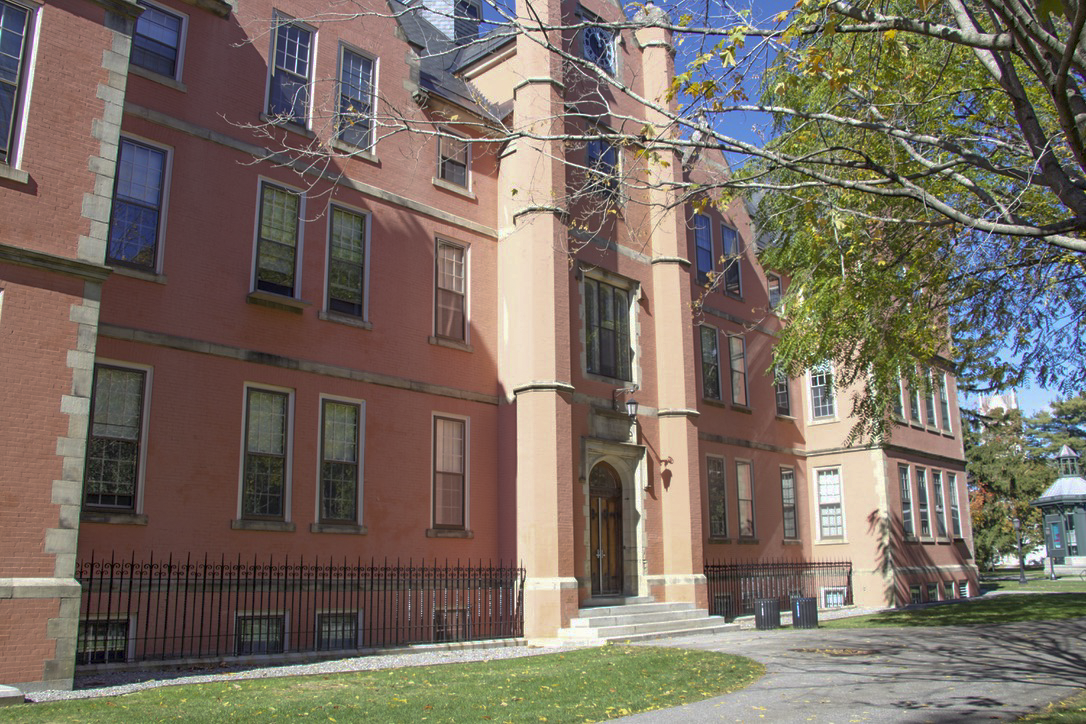What’s in a Name: Searles Hall
October 17, 2025
 Bergen Pickett
Bergen PickettWhile walking by Searles Hall on the Main Quad, students may not realize that this salmon pink building was constructed following a tumultuous love story between the widow of a railroad tycoon and an interior decorator.
One of the “Big Four” investors in the Central Pacific Railroad Company, Mark Hopkins, married Mary Frances Sherwood in the early 1860s. In 1878, however, Hopkins passed away, leaving Sherwood with a fortune of $21.7 million and the title of one of the wealthiest widows in America. During their marriage, Sherwood persuaded Hopkins to build a mansion with 40 rooms in Nob Hill, San Francisco, Calif. She continued constructing the mansion after his death and hired an interior decorator named Edward Searles.
Searles and Sherwood ended up marrying in 1887, and they divided Sherwood’s tycoon fortune between themselves. Searles had invested his newly obtained fortune into the law firm Stillman and Hubbard, managed by Thomas Hamlin Hubbard, Class of 1857. But Sherwood’s adopted son had contested her will after seeing that she had left him without any of her fortune after her death. He sued Searles, accusing him of faking her will, and Hubbard defended Searles in court—and won. As a form of payment, Hubbard asked Searles to build a science center at the College.
“When it came time to pay the bill, Searles asked what he owed Hubbard for his legal services. And Hubbard said, ‘Well, I have all the money I need. My college could use a new science building,’” John Cross, resident Bowdoin College historian and secretary of development and college relations in the Office of Stewardship Programs, said.
Hubbard initially pitched the idea of building a science building to Searles after receiving bad publicity over Sherwood’s estate settlement. The building was meant to honor Sherwood’s background in teaching mathematics, albeit neither Sherwood nor Searles had ever actually stepped foot on campus.
“During the trial, [Searles] had been forced to admit that he married [Sherwood] partly for her money and partly out of love. So, Searles was very happy to try to restore a little bit of his reputation by showing his love for [Sherwood] and for her background in teaching, and Bowdoin got a science building out of it,” Cross said.
At the time, President William DeWitt Hyde wanted a building to bolster the College’s focus on the sciences while staying true to the College’s liberal arts education. The construction of Searles Hall cost roughly $160,000 and was designed by two professors in the chemistry and physics departments.
“This building is not for the amusement of idlers on the one hand, nor the training of engineers on the other. It is intended for those who are willing to undergo a thorough course of preparatory training to fit themselves to study here; and who intend to use the results of their study as educated physicians, lawyers, journalists, clergymen and business men,” Hyde said in a speech at the dedication ceremony of Searles Hall in 1894.
While the building met the College’s practical needs as a science building, Hubbard continued to emphasize Searles’ wish to honor a building for his deceased wife. At the building’s inaugural ceremony, he gave a speech on behalf of Searles, highlighting the pair’s love story and bond.
“Of his wife he has recently written that, having passed from this life by a brief illness, she left it as her last wish that her husband should bestow all her special gifts according to his taste and judgment, known, as she said, to be in harmony with her own,” Hubbard said in 1894.
Since its construction in 1894, Searles Hall has been home to countless tales and stories. Senior Interactive Developer and author of the book “Haunted Bowdoin College,” David Francis, recounted tales of Brunswick town members entering Searles Hall to see animals kept in formaldehyde and the tiles rumored to spell out a binary code.
“A particular noise that people have talked about for years is echoing footsteps. So that’s been a legend that’s been going on for a long time…, and they turn around and they can’t see anything, although some people have said if they turn around quickly enough, they’ll see a figure in white,” Francis said. “I lately thought that maybe it is the ghost of George Pottle, Class of 1932, who climbed on the roof of [Searles Hall] to watch the solar eclipse that year, fell off and later died.”
Cross has also pointed out a notorious anomaly with the building: its clock missing the ‘I’ in ‘IX,’ so that there are two ten o’clocks.
“Fifteen years ago, they repainted the clock face, the clock that faces the campus. There are two tens and they have never fixed it. They’re aware of it, and they said that the next time they paint it, they’ll change it,” Cross said. “It is said jokingly that the physics department is messing with the time-space continuum.”
Searles Hall remains on the Quad today with its unconventional clock and salmon pink walls, constantly prompting students to debate the beauty—or lack thereof—of the brick building. In the April 30, 1971, issue of the Orient, Quill Editor Don Westfall ’72 engaged in this timeless debate, defending the neoclassical Beaux-Arts building.
“In order to spite General Hubbard, Bowdoin College, and the late Mr. Searles (apparently also disliked), [Sherwood] had designed and named for herself a particularly ugly building…. This tale is spurious; these are prevarications, lies of the worst kind!” Westfall wrote. “Short shrift must be given its elevator, its outdoor clock, its turrets, towers and spires, its careful stone work, its magnificent flying buttresses, its vaulted ninety foot high central chamber…. There is not even enough space to discuss the lives and thoughts of numberless teaching fellows whose mighty tread has caused the great stone walls to shake.”

Comments
Before submitting a comment, please review our comment policy. Some key points from the policy: